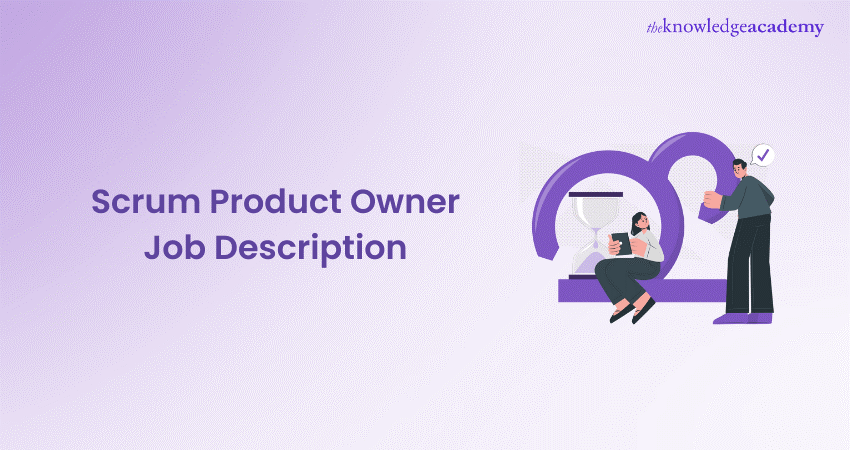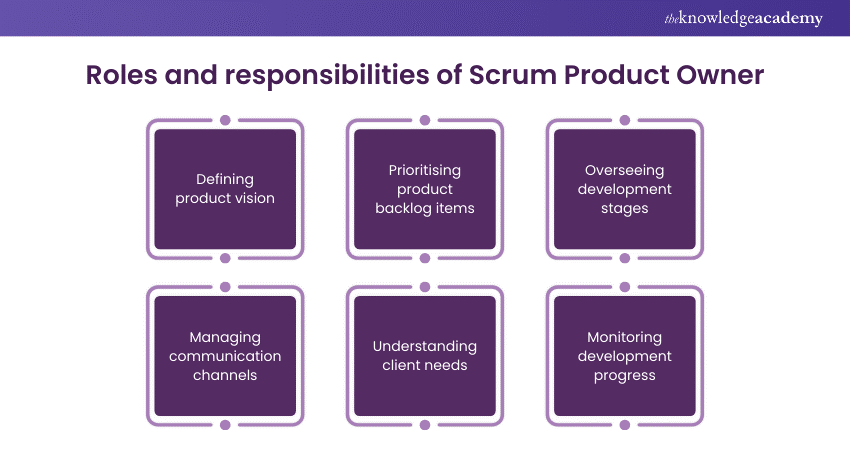We may not have the course you’re looking for. If you enquire or give us a call on +43 720 115337 and speak to our training experts, we may still be able to help with your training requirements.
We ensure quality, budget-alignment, and timely delivery by our expert instructors.

Are you interested in learning about the vital role of a Scrum Product Owner in Agile Project Management? How do these professionals navigate the complexities of the Scrum Product Owner Job Description to ensure project success? In this blog, we will explore the ins and outs of the Scrum Product Owner role. In addition to this, we will uncover the essential responsibilities and skills required to shape project outcomes. So, wait no more- let's dive into this!
Table of contents
1) What is a Scrum Product Owner?
2) Role and responsibilities of Scrum Product Owner
3) Skills of Scrum Product Owner
4) Scrum Product Owner Job Description examples
5) Conclusion
What is a Scrum Product Owner?
A Scrum Product Owner is the voice of the customer in Agile Project Management. They serve as the primary bridge between stakeholders and the Development Team. They guide the product development process from creation to delivery. Additionally, they collaborate with the Scrum Teams to create a clear vision for the product.
The Product Owner makes sure that the final product delivers maximum value. They decide which features should be developed and in what order. They also check that each development effort contributes to the overall success of the final product.
Roles and responsibilities of Scrum Product Owner
In Agile Project Management, the role of the Product Owner is an important and necessary part of the Scrum. They are a critical link between stakeholders, the development team, and project success. They hold wide duties and include many tasks, each important to drive the project to success. Some of the key roles and responsibilities of a Scrum Product Owner include:

Defining product vision
A captivating vision lies at the core of every successful product. The Scrum Product Owner is responsible for defining this vision. They work closely with stakeholders to understand business goals, market trends, and customer demands. Additionally, they communicate the goals and vision to the development team. Once the vision is defined, the Scrum Product Owner can align the team's efforts and instil confidence in the product's success.
Prioritising product backlog items
One of the Scrum Product Owner's significant responsibilities is prioritising items in the product backlog. This involves understanding business priorities and evaluating user feedback. By identifying the most valuable features and functionalities, they ensure that the Development Team prioritises developing impactful solutions that meet customer needs.
Boost your Agile projects skills with our Managing Agile Projects With Scrum Course - sign up now!
Overseeing development stages
After the Scrum Product Owner sets the vision, the Scrum Product Owner oversees various stages of product development. They work with cross-functional teams to refine, review, and validate product features. By participating in sprint evaluation, they ensure that the team is in line with project goals.
Managing communication channels
Effective communication is essential to Agile Project Management. Scrum Product Owners serve as the primary communicators between stakeholders and Development Teams. They conduct regular meetings, offer clear guidance, and address concerns to promote collaboration and alignment.
Understanding client needs
The Scrum Product Owner needs to understand and anticipate customers' requirements. They interact with stakeholders to gather feedback and integrate user insights into the product backlog. This helps ensure that the final product delivers the maximum value and meets customer expectations.
Monitoring development progress
The final accountability with respect to the product and every development stage falls on the shoulders of the Scrum Product Owner. Most importantly, he or she should work in close collaboration with the Scrum Master and Development Team so that the tasks are done within a pre-determined timeframe and quality standards. Importantly, they should make tough decisions as to whether the team is ready to move forward to the next stage of Development or if there is a need to start from scratch.
Enhance your organisational efficiency through our Scrum For Teams Course sign up now!
Skills of Scrum Product Owner
Scrum Product Owners must possess diverse skills for addressing the complexities of Agile Project Management. These skills ensure successful product development while fostering collaboration and driving innovation. Here are the skills that they need to have:
a) Collaborative approach: A collaborative approach is critical for Scrum Product Owners to work with cross-functional teams, stakeholders, and customers effectively. They foster collaboration and promote the sharing of ideas, resulting in more creative products.
b) Effective communication: Effective communication is essential for Scrum Product Owners to reduce misunderstandings and keep everyone updated at all times during the project’s lifetime. They must excel in explaining project requirements, priorities and progress to both internal team members and external stakeholders.
c) Business acumen: The Scrum Product Owner should have a strong business sense as they analyse the market trend, recognise what customers want, and decide what to do next based on market demand. This could have the highest return on investment and be a significant contributor to the project's success.
d) Adaptability: Finally, the Scrum Product Owner must be adaptable. They should be willing to alter business plans and policies and respond quickly to change. By doing so, the Scaled Agile Framework supports regular updates and tweaks the processes to allow quicker changes.
Master the Product Owner role – Download the Scrum Product Owner Guide now!
Scrum Product Owner Job Description examples
|
Product Owner- job post XYZ London Permanent Full job description The Product Owner is responsible for maximising the value of our products and the work of the engineering teams. As part of an agile team, they work directly with an engineering team and delivery manager. They are accountable for answering the questions: What products and features should we build and why, and how do we deliver these to market? This role reports to a Product Director or Group Product Manager Job Description Strategy and Vision: Collaborate in crafting your tribe’s strategy by doing deep market, customer, competitor and technology research. Secure buy-in for the product strategy for the tribe from colleagues and stakeholders. Translate the product strategy and the customer problems into the product backlog for your team. Discovery: Conduct discovery with clients to uncover potential problems and opportunities to tackle. Engage with customers and colleagues to ideate new features and products to be developed. Complete detailed discovery on things like payment files, bank or operational flows and systems maps Work with internal & external teams to develop and maintain technical documentation. Ensure requirements are detailed enough to take into sprint, including functional & non-functional requirements Delivery: Manage end-to-end product development, from planning to execution and launch. Prioritise the product backlog based on customer, commercial, and strategic value. Collaborate with the agile delivery manager on how the team is performing and how to improve the delivery performance. Participate in agile ceremonies and support the team by providing details on what is being prioritised and why. Adoption: Collaborate with the Product Marketing and GTM teams to define the go-to-market approach and product positioning. Drive product adoption across various regions, segments, and use cases. Measure and communicate product performance and impact post-launch. What Success Looks Like Delivery of product strategy, backlog, roadmap, and business cases. High-velocity shipping of new features and products that solve customer problems and generate value. Consistent delivery and detailed understanding of product development. Qualifications Proven experience in a Product Owner or Product Manager role in a software-first Fintech or tech start-up Comfortable working with agile frameworks like Scrum or Kanban Ability to define a product backlog using standard categories like epics & user stories and experience making tough trade-offs and prioritisation decisions Experience crafting a vision for your product based on customer discovery, market research, data analysis, etc. Preferably domain knowledge in Fintech - e.g. payments, FX, transaction banking or trading Personal qualities A self-starter who takes accountability for getting things done Top-notch stakeholder management skills, including the ability to influence colleagues in small, cross-functional scrum teams Analytical and commercially sharp Comfortable challenging the status quo and always curious about the way things work Great written and verbal communication skills Exceptional structure and attention to detail Comfortable working in a scale up or growth environment and as part of a wider team |
Conclusion
This understanding of the Scrum Product Owner Job Description highlights their significance in fostering product success and delivering value to stakeholders. The role of a Product Owner is crucial in Agile Project Management, as they serve as the voice of the customer and guide the development process from start to finish. The Scrum Product Owner makes sure the final product meets customer expectations.
Gain a deep understanding of the Scrum teams with our Scrum Product Owner Course - sign up now
Frequently Asked Questions
What are the key responsibilities of a Scrum Product Owner in Agile Project Management?

The key responsibilities of a Scrum Product Owner include defining the product vision, prioritising backlog items, communicating requirements to the development team, collaborating with stakeholders, and ensuring the product meets customer needs.
How does a Scrum Product Owner prioritise backlog items?

A Scrum Product Owner prioritises backlog items based on business value, customer feedback, market trends, and strategic goals. They make decisions about product features by considering input from stakeholders and aligning with the overall product vision.
What are the other resources and offers provided by The Knowledge Academy?

The Knowledge Academy takes global learning to new heights, offering over 3,000 online courses across 490+ locations in 190+ countries. This expansive reach ensures accessibility and convenience for learners worldwide.
Alongside our diverse Online Course Catalogue, encompassing 19 major categories, we go the extra mile by providing a plethora of free educational Online Resources like News updates, Blogs, videos, webinars, and interview questions. Tailoring learning experiences further, professionals can maximise value with customisable Course Bundles of TKA.
What is the Knowledge Pass, and how does it work?

The Knowledge Academy’s Knowledge Pass, a prepaid voucher, adds another layer of flexibility, allowing course bookings over a 12-month period. Join us on a journey where education knows no bounds.
What are related courses and blogs provided by The Knowledge Academy?

The Knowledge Academy offers various Scrum Certification Training, including Scrum Master Certification Course, Scrum Product Owner Training and Scrum Developer Training. These courses cater to different skill levels, providing comprehensive insights into Agile Project Management With Scrum.
Our Project Management Blogs cover a range of topics related to Scrum, offering valuable resources, best practices, and industry insights. Whether you are a beginner or looking to advance your Business Improvement skills, The Knowledge Academy's diverse courses and informative blogs have you covered.
Upcoming Project Management Resources Batches & Dates
Date
 Scrum Master Certification
Scrum Master Certification
Thu 20th Feb 2025
Thu 27th Feb 2025
Thu 6th Mar 2025
Thu 13th Mar 2025
Thu 20th Mar 2025
Thu 27th Mar 2025
Thu 3rd Apr 2025
Thu 24th Apr 2025
Thu 1st May 2025
Thu 22nd May 2025
Thu 5th Jun 2025
Thu 19th Jun 2025
Thu 3rd Jul 2025
Thu 17th Jul 2025
Thu 31st Jul 2025
Thu 14th Aug 2025
Thu 11th Sep 2025
Thu 25th Sep 2025
Thu 2nd Oct 2025
Thu 9th Oct 2025
Thu 16th Oct 2025
Thu 23rd Oct 2025
Thu 30th Oct 2025
Thu 6th Nov 2025
Thu 13th Nov 2025
Thu 20th Nov 2025
Thu 27th Nov 2025
Thu 4th Dec 2025
Thu 11th Dec 2025
Thu 18th Dec 2025






 Top Rated Course
Top Rated Course



 If you wish to make any changes to your course, please
If you wish to make any changes to your course, please


